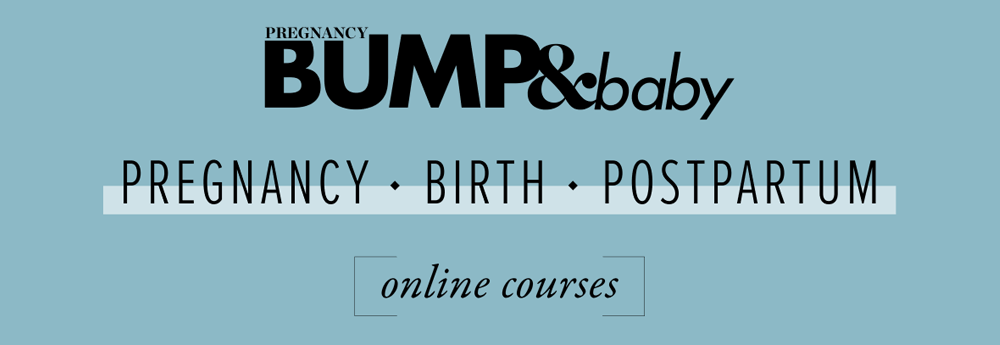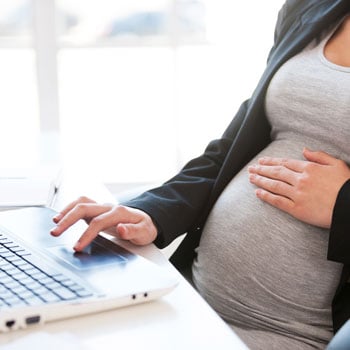
During your pregnancy you’ll be offered a number of antenatal screening tests to check both you and your baby are healthy, explains Penny Voigt.
Antenatal screening tests look for signs of possible problems with your wellbeing and the way that your baby is developing.
Although screening tests can’t detect all conditions, they can identify the presence of health conditions or diseases that may affect your pregnancy, and may be able to determine whether there is an increased chance of your baby having a particular problem.
Choosing whether or not to have the screening tests is an important decision. To help you decide which tests are most helpful during your pregnancy, we’ve outlined some of the antenatal testing available during each of your trimesters.
First Trimester: Weeks 0 – 14
Blood and urine testing
At your first pregnancy check-up, your blood and urine will be tested. Your urine will be tested for bacterial and fungal infections, while your blood will be checked to determine:
- Your blood group;
- Your Rhesus factor to identify whether you are Rhesus positive or negative;
- A full blood count to measure the level of iron, folates, and B12 in your blood;
- Whether you have Rubella (German Measles) antibodies;
- VDRL to check for sexually transmitted infections and an HIV-AIDS test; and
- If you have diabetes or whether you are at risk for developing diabetes.
Screening for Down syndrome and other conditions
During your first trimester, you’ll be offered a combined screening that will indicate whether your baby has a low or an increased chance of having Down syndrome or another condition.
The screening includes a blood test that will measure two specific biochemical markers present in your blood, and an ultrasound scan of your baby to measure the nuchal translucency of the uid- lled space at the back of your baby’s neck.
The best time for the blood test is when you are nine to 10 weeks pregnant, but it can be done right up until 13 weeks and six days of pregnancy. If you are already between 14 and 20 weeks pregnant, second trimester maternal serum screening is offered, which involves a blood test. An ultrasound scan of your baby is ideally done when you are 12 weeks pregnant, but it can be done at any time between 11 weeks and two days and 13 weeks and six days.
Harmony Prenatal Test
A non-invasive alternative to rst trimester prenatal screening is the Harmony Prenatal Test: A DNA-based blood screening test that evaluates the risk of Down syndrome (trisomy 21), trisomy 18, and trisomy 13, delivering accurate results from as early as 10 weeks of pregnancy. When you’re pregnant, your blood contains fragments of your developing baby’s DNA. Using your blood sample taken at week 10 of your pregnancy or after, the DNA sample is analysed and test results are available within seven days. The Harmony test has a higher detection rate for trisomy 21 than combined first trimester screen but it is non-funded, so you will have to pay.
Other tests
Regular checks that you can expect during the course of your pregnancy include blood pressure, urine, and weight, as well as the size of your baby bump and your baby’s heartbeat. These tests are done regularly to check that your baby is growing as expected and that you are not showing any signs of problems during your pregnancy.
What is down syndrome?
Down syndrome is a lifelong condition that is present from conception. It occurs in approximately 1 in 1,000 births, and women of any age and ethnicity can have a Down syndrome baby. People with Down syndrome have an extra copy of chromosome 21, which results in learning di culties and can cause health problems.
While Down syndrome is the most common condition indicated by antenatal screening, other conditions indicated in the screening include Patau syndrome (called trisomy 13) and Edwards syndrome (called trisomy 18); also caused by extra copies of chromosomes, both conditions can lead to life- threatening complications that severely a ect the brain, heart, and kidneys.
Results from your blood test and your baby’s scan are combined with factors such as your age and weight to determine the chance of your baby having one of the screened conditions; screening cannot tell you for sure though whether or not your baby has a condition.
Your screening test results may also indicate that you have a higher risk of developing problems later on in pregnancy.
Results should be available to you within seven to 10 days. A low chance result means there is very little chance that your baby has one of the screened conditions, while an increased chance result means there is a higher chance that your baby has one of the screened conditions. If you receive an increased chance result, your LMC or doctor will discuss what your results mean and help you decide whether to go forward with diagnostic testing. It’s important you have enough information to help you decide about screening and testing for Down syndrome and other conditions. If you need more information, ask your LMC, doctor, or specialist, or visit the National Screening Unit’s website (nsu.govt.nz).
To find out more:
- New Zealand Down Syndrome Association 0800 NZDSAI (0800 693 724) or nzdsa.org.nz
- New Zealand Organisation for Rare Disorders nzord.org.nz
Second Trimester: Weeks 14 – 30
Prenatal diagnostic testing
While first trimester screening gives an indication of an increased chance that your baby has a screened condition, prenatal diagnostic testing provides a 100% diagnosis of a chromosome abnormality.
The most common types of prenatal diagnostic testing are chorionic villus sampling (CVS) and amniocentesis. The type of sample collected depends on how many weeks pregnant you are; before 14 weeks, a sample of the developing placenta is taken (chorionic villus sampling); from 15 weeks, a sample of amniotic uid is taken (amniocentesis). As it is considered an invasive means of determining the presence or absence of a chromosome abnormality, prenatal diagnostic testing is usually only performed in certain situations.
Chorionic villus sampling (CVS)
A CVS test may be recommended for women over 35 years old who have received an increased risk result on their rst trimester screening, or who have a history of chromosomal or genetic disorders. CVS is performed earlier in pregnancy than amniocentesis, but carries a higher risk of miscarriage; approximately one in 100.
Usually performed between 10 and 13 weeks of pregnancy, it involves inserting a thin needle through the skin on your abdomen or using a speculum through your vagina/cervix into the placenta to obtain a small amount of placental tissue from the developing pregnancy. At the same time, a scan is done to guide the position of the needle or speculum.
As the placenta contains chorionic villi which usually have the same genetic makeup as your baby, the sample taken will be cultured in the laboratory and the chromosomes in the chorionic villi will be examined for any abnormalities. CVS results should be available within 10 to 14 days.
Amniocentesis
Amniocentesis is usually performed from 15 weeks of your pregnancy, and involves inserting a thin needle through your abdomen into the amniotic sac (the fluid around your baby) to obtain a small amount of amniotic uid. The fluid contains cells that are shed from your baby’s lungs and bladder, and can be examined for their chromosomes. Results are usually available within two weeks.
Rapid FISH testing
You can request a quicker result from your CVS or amniocentesis testing with the rapid FISH test ( uorescent in-situ hybridisation), although this test is non-funded so you will have to pay extra for this. Results from the rapid FISH test are usually available within 48 hours.
As this test only examines chromosomes 13, 18, 21 and the sex chromosomes (X and Y), the most common abnormal chromosomes, this rapid result does still require con rmation with the long-term culture results, which are more reliable. A normal FISH result is reassuring, but it does not exclude all chromosome abnormalities.
Abnormalities detected on CVS or amniocentesis include extra chromosomes (such as trisomy 21 or Down syndrome), missing chromosomes (such as 45, X0 or Turner syndrome), deletions of portions of chromosomes, or re-arrangements of chromosomes (such as translocations).
Anatomy scan
When you are around 18 to 20 weeks pregnant, you’ll be offered another scan where parts of your baby’s body will be measured to check that they are growing as expected. This is called the anatomy scan. It takes longer than other scans because there is a full set of measurements which need to be taken and recorded, so you may be at the radiology clinic for an hour or more. You may be able to find out your baby’s gender too, although sometimes babies don’t like to show their bits, so be aware it’s not always possible!
Diabetes screening
During your pregnancy you will have two opportunities to have diabetes screening. The rst is your antenatal blood test and the second is when you are 24 to 28 weeks pregnant. The screening detects whether you have diabetes or are at risk of developing gestational diabetes.
Third Trimester: Week 30 onward
Late pregnancy scans
Usually late pregnancy scans are only offered if problems were picked up during your earlier scans. Your midwife may request that you have a growth scan (to see how your baby is growing and to check it’s on track), a scan to determine that your amniotic uid levels are optimal, or a scan to determine the position of your baby in the womb.
Screening for group B strep (GBS)
If you have a higher risk of having group B strep, bacteria found normally in the intestine, vagina, and rectal area in about 25% of all healthy adult and pregnant women which can make your baby sick, a swab of your perineum (the area from the bottom of your vagina around to your anus) will be offered when you are 35 to 37 weeks pregnant. If you are found to have group B strep, you will be offered antibiotics while you are in labour to help protect your baby.
BUMP&baby
BUMP & baby is New Zealand’s only magazine for pregnancy and early babyhood. Our team of mums and mums-to-be understand what it’s like to be pregnant in this connected age, and that’s why BUMP & Baby online is geared toward what pregnant women and new mums really want to know.
Other articles of interest
Maternity leave: 8 essential questions answered
Parental leave entitlements can be a bit confusing. Here’s a quick guide to what you need to know.







